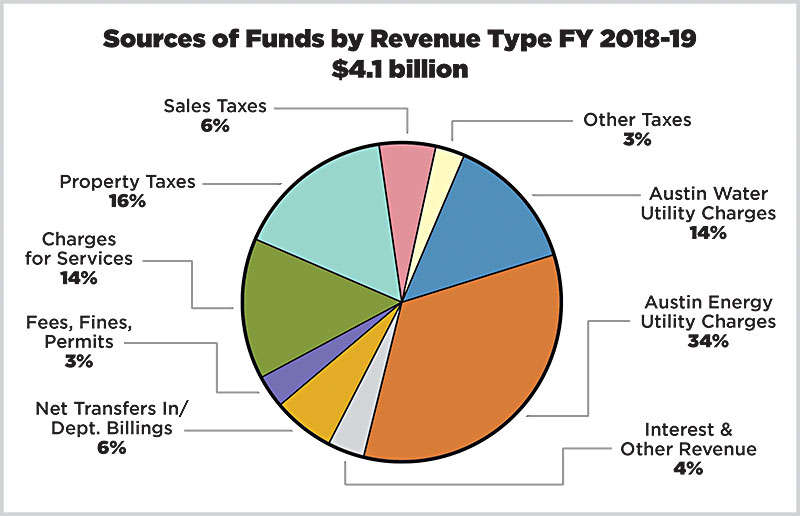Breathing Room for the City Budget
Proposed FY 2019 city budget features sunnier projections
By Michael King, Fri., Aug. 10, 2018
"Strategic Outcomes" will take some getting used to.
That's one takeaway from the FY 2019 proposed city budget formally presented by City Manager Spencer Cronk Monday afternoon at the Mexican American Cultural Center. Although the budget staff continues to track revenues and expenditures traditionally, by individual city departments, the proposed budget will also be macro-organized by six City Council-defined "strategic outcomes":
• economic opportunity & affordability;
• "safety" (writ large);
• culture & lifelong learning;
• mobility;
• health & environment; and
• "government that works for all."
Council and City Hall are officially enamored of this new organization, but whether it will make explanatory sense for the public at large remains to be determined.
Another new aspect of the budget delivery this week was embodied by Cronk himself, who in his first year at the helm personalized the budget presentation – historically a fairly informal handoff to the budget staff in an all-day Council work session – into a expository speech at the MACC. He definitely got better attendance – a packed house in the main gallery, including a visible percentage of city staffers but also plenty of interested observers. Cronk also cited a dozen or more public outreach meetings in budget preparation; the obvious intention is that all of this will translate into more public buy-in for the budget itself. (The council introductory work session – with more to follow in August before formal adoption in September – will still happen.)
Cronk was coy last week when asked if the proposed city budget numbers appeared to be in the same range as the estimates previewed to City Council in April. "You'll just have to wait until the presentation," he said. The cat is now out of the bag, and not as skinny as anticipated.
In his April preview, Deputy Chief Financial Officer Ed Van Eenoo reported that previously robust revenue streams – primarily property taxes, sales taxes, and development fees – were not keeping up with rising expenses. Predictable "cost drivers" – rising salaries, insurance costs, new facilities – have been annually increasing at a steady 5%, but the revenue streams are no longer hitting similarly sustainable targets. The unflappable Van Eenoo told Council, "The story is those revenues are growing less than four to five percent per year. If the budget is growing four to five percent per year, I need everything to grow, [but] the sales tax, utility fees, and everything else is growing less than four to five percent."
Those early numbers have since been tempered by a few unexpected moderating factors. One is a surprisingly flat year in health insurance costs – after several years of 8 to 10% increases in the city's self-insurance for its employees, the budget staff anticipates "no increase in health insurance premiums for employees and retirees." At a Monday morning media briefing, Van Eenoo said there were simply fewer "major" claims this year – serious illnesses or injuries, lengthy hospital stays – so that costs were flat overall, creating no insurance "cost driver" for the budget and therefore no premium bump for employees.
Yet another financial windfall of sorts might be called the "public safety bonus." Of the three major public safety departments, only Fire has a negotiated labor contract, with a comparatively low salary-increase schedule (Van Eenoo described a 0.5% increase in the first year, 1% in the second). What will happen for police and EMS is yet to be determined (those contracts remain under negotiation), but in the meantime, the proposed budget anticipates not as big a spike in labor costs as in past years. (Since negotiations are ongoing, the budget staff is using confidential "placeholders" for those potential costs.)
Finally, public safety costs have been weighed down in recent years by a federal consent decree covering Fire Department hiring, meaning deferred cadet classes and therefore additional costly overtime for current firefighters. Due to recent adjustments and (finally) new cadet classes, Van Eenoo says the department is "over the hump" on overtime costs and therefore seeing less of a budget spike. (For more on that, see "Funding Public Safety?," Aug. 10.)
Mindful of perennial public focus on public safety concerns, Cronk's presentation and the budget briefing highlighted increased public safety spending (proposed and over the last few years). According to staff calculations, the years FY 2016 through the proposed FY 2019 budget reflect an 18% increase in public safety spending overall ($107.6 million). That includes 85 new sworn positions in EMS, 68 new firefighters, and 83 new police officers.
The Big Numbers
As usual, the city provided headline numbers for big-picture framing. Here are a few highlights:
• $4.1 billion: The "All Funds" budget, including both General Fund (expense) and the Enterprise (self-funding) departments, representing a 4% increase over FY 2018.
• $1 billion: The GF budget, but with the $53.9 million increase offset by moving Development Services to become an Enterprise department, there's a net increase of only $0.6 million.
• 4.9%: the proposed property tax rate increase, leaving room for Council adjustment upward (Cronk mentioned 6% as an upper limit, as Council had requested in the spring); there will be much additional discussion pending.
• 4.3%: Sales tax growth projection (more optimistic than April numbers, meaning more flexibility in budgeting).
• 2.5%: Across-the-board increase for civilian employees ($18.5 million citywide).
Fee and Rate Changes
If these numbers hold (and Council decisions generally result in some adjustments), Austinites can expect a relatively mild year of increased fees and rates. As calculated and itemized by the budget staff, and based on a median value home to be assessed at $332,366, we'll see increases of:
• Austin Energy: $2.76/year
• Transportation User Fee: $15.24/year
• Property Tax Bill: $61.48/year (non-senior, 10% homestead exemption).
The Resource Recovery, Clean Community, and Drainage Utility fees are all proposed at no change, and Austin Water will actually reduce fees nominally ($1.44/year). Altogether, the combined recommended changes amount to a 2% total increase for that median-value homeowner ($78.04 for the year).
Early Returns
Prior to his public presentation, Cronk made the rounds of Council offices to provide previews for his official audience. Council members indicated they were a bit surprised by the relatively good news, and were looking forward to working through a budget with a broader policy perspective and fewer intractable choices. "If what we were told was accurate," said Jimmy Flannigan, "we're going to see a budget that has quite a bit of flexibility."
In addition to endorsing a renewed emphasis on "policymaking" vs. "line-item minutiae," Flannigan praised the full funding of the Housing Trust Fund, as well as more funding committed to long-deferred maintenance of city facilities. He especially welcomed the prospect of a relatively low property tax bite – Flannigan led the applause when Cronk recommended 4.9% in his presentation – although Council will still consider whether to raise the rate in anticipation of the governor and Legislature's threat to lower the existing 8% cap.
Mayor Pro Tem Kathie Tovo was pleased about increased funding for the affordable Housing Trust Fund ("very exciting"), for programs to address homelessness, for historic preservation funding via the Hotel Occupancy Tax, as well as the overall wage increase for city employees. "It sounds as if it's a better year than the last several," Tovo said. She'll be asking for clarity on how all that was accomplished, but said she remains open to Cronk's new process. "As long as we preserve sufficient time to really dig into the details, this should work," Tovo said. "Yes, we accept the strategic priorities, and the budget will flow from those strategic priorities, but ultimately, we still need to pass that budget – so we need to be very comfortable with what's in it, and comfortable that the right programs and resources are being funded."
Delia Garza also described the city manager preview as providing "good news," noting that public safety and health insurance appear to have delivered unexpected savings. "That allowed them to start off with a lower tax rate," she said, "and then leave it up to Council whether we decide to go to the rollback rate." She praised progress on expanding fire service (new stations are proposed for Del Valle and Travis Country) and on the continued remodeling of existing stations for gender equity. Another priority for her, she said, has been trying to encourage a grocery store for the far southeast area of her District 2, where small farmers' markets are currently filling the gap. "I've also been talking to city staff about funding a market study for a grocery store in that area," Garza said, "since it's something that needs to be done and it's my understanding that it's relatively low-cost."
Finally, asked about the persistent Council debate over what constitutes "public safety" – more law enforcement vs. the health and human services programs she champions – she said, "I think there's got to be a delicate balance: Being proactive, some of our contracts help low-income youth in our community, and they do make an impact on youth and children's lives in our community, and it's important that we get to them early. But at the same time, we're always going to need a police force, and it needs to be properly staffed and funded."
The Big Concepts
In his MACC presentation, Cronk was inevitably upbeat about the progress and the challenges represented by each Strategic Outcome, providing a requisite acknowledgment of every council member on hand (and one who wasn't, Ellen Troxclair) for "leadership" in the various priorities. (Pio Renteria got a nod for affordable housing, Tovo for her work on homelessness, Ora Houston for health care outreach, and so on.) Framed by poster boards laying out the six outcomes, Cronk broke out programs and spending on those he wanted to emphasize. Among them were the Housing Trust Fund (fully funded for the first time, at $5.3 million); bringing all employees (full-time, part-time, and temporary) to the aspirational living-wage floor of $15/hour (a year ahead of schedule); adding $1.8 million for badly needed pool maintenance (funded by a hike in entrance fees); and large increases in mobility funding from both operating funds and voter-approved bond money.
Cronk credited the absent Troxclair for promoting to her colleagues another bump in the homestead exemption – 2% additional, now 10%, in total a $24 million hit to the GF budget, yielding a beneficent $12/month to that symbolic median homeowner, and more to his wealthier neighbors. When Council begins calculating "unmet needs" in late August, that missing $24 million would certainly come in handy.
Consider, by comparison, the meager $1.9 million it will cost to move the lowest-wage civilian city employees from $13.84/hour to a princely $15. A couple of people who attended Cronk's presentation will be direct beneficiaries of that modest increase.
Madora Rangel works in food service at ABIA; under the city's existing private contracts (in this case, with airport food service contractor Delaware North), wage increases provided to civilian city employees are extended to city contractors as well. "Right now I'm living paycheck to paycheck," Rangel said, and what seems a small increase amounts to almost 10% of her current hourly rate. "For me and my family, it will definitely make a difference."
Joel Manzo is a four-year lifeguard at Barton Springs, and audibly proud of his service to the city and the pool visitors. "We save lives, we make sure everybody goes home safe with their families, and [noting that lifeguards do much more than just watch swimmers] we provide a clean and safe swimming environment." He said previous city raises have meant more and better recruitment, and less required overtime. "We need to make this wage a base, and reward employees for better work and for taking on more responsibility."
It's a cliche that budgets are moral documents. But "line items" like these – tax exemptions for homeowners, wage floors for working people – can say much about a city's relative priorities, its leadership, and its voters and residents. Cronk's proposed budget now makes its way directly to City Council, where the coming decisions will continue to reflect much about the relative priorities of Austin and Austinites.
The $4.1 billion "All Funds" Budget


Got something to say on the subject? Send a letter to the editor.











